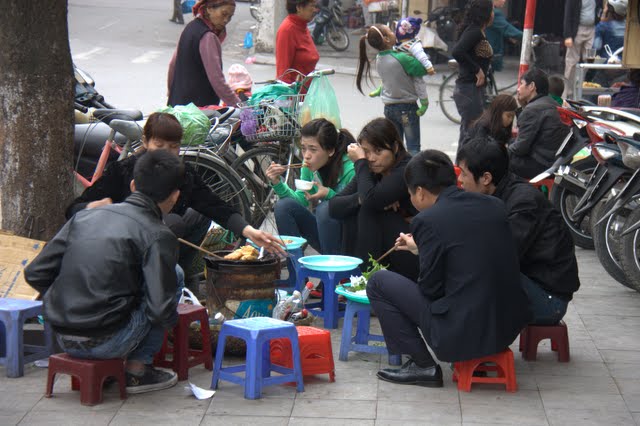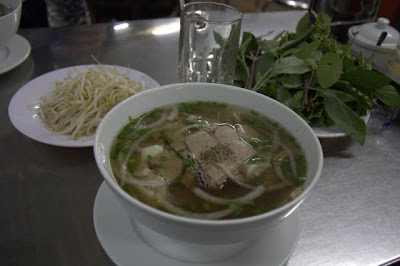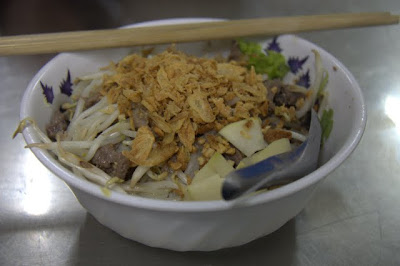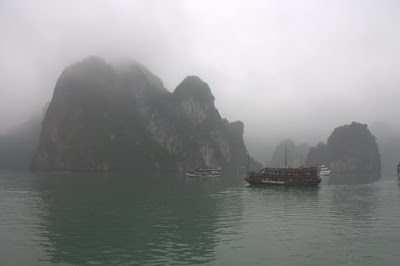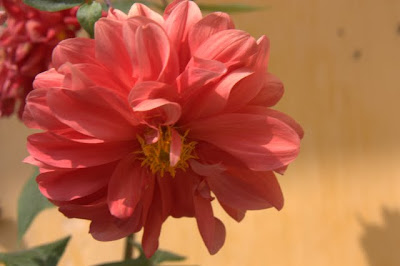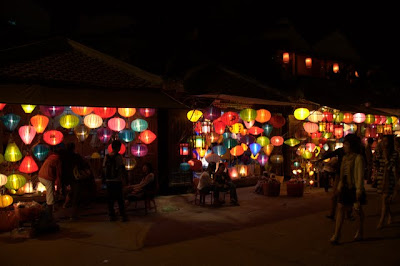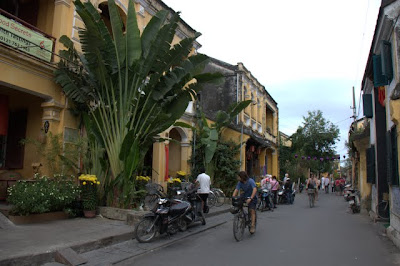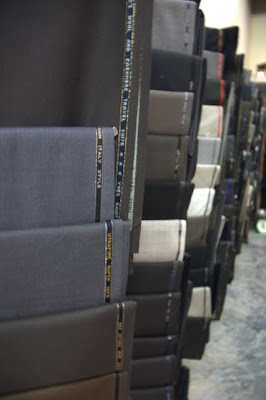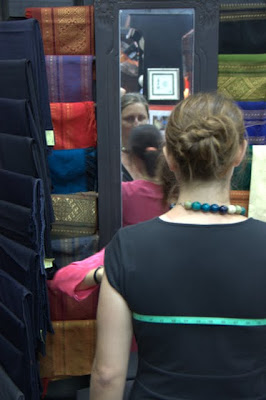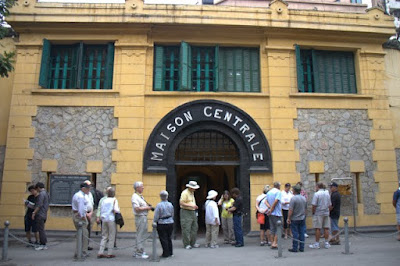Eating Vietnam Out of House and Home
If there’s one thing I could say about our month in Vietnam, it’s that it was one tasty month. While we normally grow weary of a country’s cuisine by the end of our time there, I could have kept eating Vietnamese even after we left, and mentioned to Sean I had a hankering for spring rolls after we passed a Vietnamese restaurant in a Bangkok mall.
Thanks to Tram’s Kitchen in Bloomfield at home, we’d already sampled Vietnamese food before this trip, so we were eagerly awaiting to try some tasty eats in Vietnam itself (on eight inch stools, of course). Beginning meals in the Mekong Delta were disappointing – here’s a tip; don’t order Pho All because the all is quite scary, indeed – but things improved quickly. Each region has its specialties, so there’s more nuanced variety than you first realize. Here’s some of our favorites (not to mention the runners up of stir-fried cactus at fresh veggie-centric and beautiful Cuc Gach Quan in Saigon; cao lau noodles and white rose dumplings in Hoi An; any of the delicious things My and Mr. Pepperman had us try in the Central Highlands; any sort of street-made dumpling or bun cha in Hanoi; and the many tastings of chicken stir-fried with chili and lemongrass countrywide):
Fresh spring rolls
Without a doubt, our favorite meals are fresh spring rolls. Surprisingly, these can be hard to find – probably because I wanted them with every meal. The pre-rolled ones were tasty – especially if they are being rolled right next to you seconds before you eat them, like ones we had at a market in Saigon – but there’s something about rolling them yourself. Our first encounter was at the market in Dalat. (Are you noticing a theme? The best food is at Vietnamese markets.) We hovered near a food stall, trying to figure out what the heck they were serving as everything was in Vietnamese. A kind woman took pity on us and come over from where she was sitting at a different restaurant. She suggested that we try the spring rolls being served at the stall in which we were standing by since they were the best in town. With that ringing endorsement, we gratefully let her run interference between us and the women behind the stall, who only spoke Vietnamese. When you’re at a make your own spring roll place, you receive rice paper for rolling, spicy peanut sauce for dipping, and lots of fixins’ for stuffing: rice noodles; pork prepared multiple ways; lettuce; mounds of fresh mint, basil, and other herbs; and raw banana, starfruit, cucumbers, and fried rice paper for crunch. Words can’t describe how fresh, how tasty, how crunchy, how tangy fresh spring rolls are in Vietnam. When our Easy Rider guides took us to a fresh spring roll restaurant on our second night at Buon Mi Thiout, I nearly died of happiness.
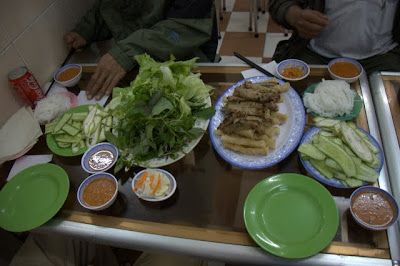
This Buon Mi Thiout restuarant's specialty is the hot peanut sauce accompaniment, seen in the right hand corner.

At the Ben Thanh market in Saigon, I was inches away from this women while she rolled up our order. Don't be afraid of the Spring Roll Nazi woman who patrols around you while you eat.
Fried spring rolls
While the fresh ones beat the fried ones by a landslide, I was a fan of the fried ones as well, especially those fried with a light touch, like the ones at Madame Foung’s place in Hoi An. Madame’s restaurant is called the Light Candle. If she’s not in the back cooking, she’ll call out to you like all of the other vendors in Hoi An. But if you come in, unlike some others, she’s be really, truly glad you came. We half-ignored Madame Fuong one afternoon as she was one of many voices calling out for us to buy something or come inside. But then when we couldn’t find the restaurant we were looking for, we turned around and decided to try the Light Candle. Madame came rushing over to us, and exclaimed, with genuine joy and enthusiasm, Oh! You came back! You came back! We would have returned just for Madame’s cheerful demeanor (even though she only speaks a few words of English), but her food matched her attitude. The Candle Light spring rolls, as she calls them, are sublime. If you go, try them; she’ll make you order them anyway. You’ll be glad you did.
Pho
Once we recovered from the Pho All debacle, we become pho addicts. Not all phos are created equal; some are just too rich for our liking, but most have a delightful blend of meat stock (created by bubbling overnight in a giant pot), tender beef or chicken, long skinny white noodles, savory spices like cinnamon, star anise, cloves and cardamom, fresh bean sprouts, chili peppers, and lime. The best phos are served at non-descript roadside restaurants doubling as the family’s home or from big vats on sidewalks, eaten on tiny chairs while the city hustles by. Pho is typically eaten for breakfast, although you can find pho at all times of the day. I have strict notions of what is breakfast food and what is not, and soup is the last thing I thought I’d want for breakfast. But we quickly realized the $1.25 steaming bowl of soup was a much tastier alternative than the Vietnamese adaptation of plain egg omelets for Westerners, so we started eating pho whenever we could get our hands on it.
Bun Bo
We only got to try this heavenly dish once, in Hanoi. If we’d had it sooner, surely we would have been searching for it high and low. Bun bo (the Vietnamese words for noodles and beef) has, well, bun and bo, along with fresh lettuce, coriander, basil, beansprouts, and crushed peanuts. Then’s there’s some sort of delectable sweet sauce to top it all off. Yum.
Fruity Goodness
Out of all of the Southeast Asian countries, we found the tropical fruit to be the freshest and tastiest in Vietnam, especially in the Mekong Delta. There was such variety, and we tried as much as we could. Our favorites were the juicy pomelos; ordinary watermelons that taste like summer in every bite; and the exotic dragonfruit.

The dragonfruit is beautiful to admire and delicious to eat. The ones with white flesh aren't as sweet, but they're juicy with little crunchy seeds like a kiwi.

The elusive red dragon fruit. Sweeter than the white ones, they're worth the hunt and extra cost. Don't be alarmed by the toilet over the next few days.

A partially peeled pomelo. Even with a knife, they're a pain to peel; shell out for the ones that are already peeled.
Moody Mystical Halong Bay
Our last stop in Vietnam was at the moody, mystical Halong Bay. Halong Bay gets a bad rap because it is one of the top tourist spots in Vietnam and it is difficult to see it without going along with a pre-arranged tour. Some tour operators are honest, but many others cut corners. With tours ranging from luxury to bottom of the barrel, it is hard to trust that you will get your money’s worth.
Because of all of the horror stories, I was apprehensive about going to see Halong Bay. Then, just a few days before we planned to visit Halong Bay, something far worse than shoddy service or overcrowding happened. One of the junk boats used for tours of the bay sunk in the early morning hours as people were in their cabins sleeping, killing 12 tourists and crew, including two college-aged American girls. By all accounts, the tour was one of the cheap budget tours, but it still doesn’t make you feel confident about your safety.
We thought about not going, but considering Vietnamese officials were inspecting every boat rigorously in the aftermath of the sinking, we decided to book a one night, two day mid-priced tour through our hotel with Amigo Cruises. The boat was relatively new, with all important safety features like life jackets. I’m not going to lie; I slept a lot easier because our room was on the upper deck. While our tour wasn’t without issues (average food, gas smell in an otherwise nice cabin room, rushed kayaking in the Bay), the tour allowed us to experience beautiful Halong Bay safely.
Despite all of the tourists, there’s a stillness and quietness in Halong Bay. I’m sure this feeling was exacerbated by the somberness of what had transpired only days before, as well as the thick fog that hung heavy in the air, especially on our first day. With limestone karsts jutting up from the waters all around you, it is a beautiful place worth visiting, as long as you can do it safely. I hope that this latest accident causes safety standards to increase; unfortunately, I don’t have high hopes as this is the first fatal boating accident in Halong Bay.
Hoi An Custom Couture
Hoi An is one of those places you kind of love, kind of hate. I don’t usually like to complain that a place is too touristy. After all, I’m there, aren’t I, and why do I think I get to hog a good thing all to myself and not share with other outsiders? But Hoi An takes touristiness over the top. By all accounts, it could be a delightful little city. It’s a UNESCO World Heritage site with historic old buildings and shophouses, all painted yellow, many punctuated by colorful flowers out front. The streets are lined by rivers and criss-crossed by bright lanterns. The shophouses are filled with stores selling trinkets to tourists, restaurants, and tailors. Sounds good, right? Well, the problem is that the locals took a good thing and ran out of control with it. Who’s to blame them, really, because the tourists were eating up what was on offer. Hoi An became known as the little town in Vietnam where you could get a custom wardrobe tailor made to your exact measurements for rock bottom prices. Where there was once a few tailors, there is now over 600 tailors, all asking you as you walk by to buy something, come into my shop, you want dress? You want suit? I can make you anything, very cheap! No time? No problem. The Hoi An tailors can turn around a entire men’s suit, with a shirt and tie to match, from scratch in less than 24 hours.
As you can imagine, out of the 600+ tailors, some are very good, some are very bad, and many are average. Sure, there are “couture” like deals to be had, but the reality is, whether you show them a picture or not, most of what they’re churning out is replicas of standard patterns.
Nevertheless, if you’re a fan of clothes and shopping, you’ve been wearing the same four outfits for almost a year, and you’ve got nightmares of job interviews dancing around your subconsciousness, you start thinking it would be kinda fun to get in on the action. So I did.
I had a custom suit tailored at B’Lan, modeled roughly after a JCrew picture I grabbed on the internet the night before. I debated about going to Yaly Couture, the shop in town with the best reputation for suits and with the highest prices, but I fell in love with a grey pinstripe Super 110 wool at B’Lan. The first take was not good. The pants, despite being measured rather extensively, could not even be zipped. And the jacket? Well, let’s just say whoever sewed the jacket must have been watching Star Trek the night before. After I got them to majorly tone down the shoulders and majorly widen the pants, the second take was better. All in all, I probably had seven fittings to get it right.
In the end, there are things I don’t love about the suit. You need to be very precise in what you want, right down to every little pintuck and button. For example, I paid more to have the suit lined. What I ended up with was a lined jacket and unlined pants. The response of the sales representative at B’Lan was that suit pants are always unlined. Since I have lined suit pants at home, I know that’s not true. Maybe in Asia, but not as a general rule. Plus when they offered me the lining option, they never specified it was for the pants. Then again, I never specified it was for both the pants and jacket. So there you go. They begrudgingly offered to remake the pants for a reduced fee, but in the end, I didn’t want to sink any more money into the suit. The pants are also a little straighter than I envisioned, but I realized I probably didn’t communicate what I wanted in a clear enough fashion. The sample suits I saw at Yaly look a little more finished, but overall, the fabric is nice and the suit is cheaper than what I’d pay at JCrew. The real test will be whether it holds up over time. We’ll see – right now it is still enroute from Vietnam to Pittsburgh. Hopefully it will get home in time for job interviews. Oh God I just threw up in my mouth a little.
I also had a casual dress made at a little shop I wandered by. The name of the shop is something like Hieu Vai Gia Dinh Family Cloth Shop. Many of the dresses on display in town are similar and rather flimsy, but I liked the fabric in the window. From a catalog of dress patterns, the tailor and I designed the dress based upon parts of patterns I liked. She whipped it up, with a lining, in something like 12 hours’ time. One set of tweaks, and it was good to go. I really love the dress and it was fun to design something from scratch without making a major investment.
Despite the tailors’ best efforts, Sean never gave into having a suit made, although he wavered once or twice. They were trying to sell to the wrong man; he already has a suit, and he wears the same suit to wedding, funerals, job interviews, and my old firm’s holiday parties. But he did end up having a suit made, albeit of a much different variety. I may have mentioned before Sean is obsessed with keeping our packs light, even to the point of recording our bags’ weights on his Ipod at the airlines’ weigh ins. He is so obsessed, he insisted upon using a pair of his shorts as his swim trunks. This worked fine when we were only visiting beaches now and again, but with a month of straight beach time coming up, he finally caved into wanting separate swim trunks. (But only if he could ditch the shorts, of course).
We saw a pair of swim trunks in the window of a tailor shop in Hoi An, and wouldn’t it be fun to have custom swim trunks made turned into actually having said swim trunks made. There was only three problems. (1) The trunks turned out to be REALLY ugly. I guess we’re bad designers. (2) At $15, the trunks were three times what he could have spent buying one of the thousands of pairs of board shorts sold on the streets. (3) The lining was rather, um, small. So the swim trunks never saw the light of day, and some hotel employee is now the proud owner.
In the end, getting custom clothes made in Hoi An wasn’t all it cracked up to be. It was fun getting something you designed made to your exact measurements, but I don’t think it is worth any major investments. Spreading out your purchases from different tailors definitely helps in case the tailor turns out to be a dud, but it also means you’ll be running all over town to fitting appointments. If I had to do it over again, I would have a fun casual dress made and maybe a going out shirt made from Vietnam’s beautiful silks, but that’s it. I wouldn’t have gotten the suit made. We’ll see how it fares, but I have the sneaking suspicion I’ll wear it a few times and then ditch it for a JCrew suit bought on sale. We’ll see; maybe I’ll be surprised. Or, ideally, I’ll have a job where I won’t have to wear a suit.
Total price: $190 (premium wool pants and jacket + silk/poly blend lining for jacket) + $15 (swim trunks) + $26 (casual cotton dress, lined) + $37 (3-4 month shipping to United States for suit, sandals I sent home, and four Vietnamese lanterns direct from B’Lan).
The Vietnam War from a Different Perspective.
The Vietnam War, as we Americans call it, looms large in American history. Thousands and thousands died in the war on all sides. Many thought the United States’ involvement in Vietnam’s affairs was a mistake, and the opposition to the war defined a generation. Most people our parent’s age grew up watching footage of a far away land on the news; younger generations grew up watching movies dramatizing the Vietnam War.
While we were in Vietnam, we took the opportunity to try to learn more about the Vietnam War. Just being where the war actually took place opens your mind to a different perspective. War becomes a lot more real when you met the “other” face to face and see the places with your own eyes. It also allows you to learn things that American history classes at home leave out. For example, before traveling through Southeast Asia, I never knew that the United States’ involvement in Southeast Asian affairs extended far behind Vietnam and included extensive side bombings of Cambodia and Laos, as well as implicit support for the evil Khmer Rouge government.
As part of our education, we visited a number of museums and exhibits. We toured the Reunification Palace, which is a time capsule of the way it was on the day the North Vietnamese army tanks rolled through the front gates in 1975 when the NVA finally captured Saigon; the War Remnants Museum, which tells the story of the Vietnam War from the perspective of the victors, i.e. the current socialist government; the Demilitarized Zone, the dividing line between North and South Vietnam; the Chu Choc tunnels, where a North Vietnamese village hid and lived underground for two years while bombs raged overhead; and the so-called Hanoi Hilton, where John McCain and other American prisoners of war were kept (and tortured) by the North Vietnamese.
As you can imagine, the current ruling Vietnamese government, as the victors of the war, have quite the different perspective on things. For starters, they don’t call it the Vietnam War; they call it the American War, or more bluntly, the American War of Imperialism. The War Remnants museum is peppered with references to the American aggressors and the South Vietnamese puppet government. It also shows many of the horrible effects of the war – but only those effects of acts committed by the Americans. Unfortunately, there is no shortage of acts to show.
All of the war related museums in Vietnam seemed to start out the same: with exhibits after exhibit showing the world’s opposition to the war. While there is no doubt there are many people worldwide that were opposed to the United States fighting in Vietnam, the captions on the pictures had their own spin, such as the one stating “American people demonstrated to support the Vietnamese struggle for independence and unification of the country.” Hmm, I could be wrong, but I don’t think that is quite what the Americans were protesting about.
The museums are full of references like these, to independence. At first, I was confused whose independence they were talking about. Whether the United States should or should not have gotten involved is a different matter, but I’ve always understood the war as being about the Americans and their allies fighting on behalf of the South Vietnamese to stop the North Vietnamese from spreading communism south. My wiser husband had to explain to me the obvious; from the current government’s perspective, they were liberating the South Vietnamese from the United States’ imperial ways and reuniting the country they never thought should have been divided.
Since the war-related museums were so extremely one sided, my antennae was up the whole time, and it was hard to trust what I was reading because I felt like much of the story was being left out or distorted. But, on the other hand, I felt there was an important lesson. How much of what we have learned in the past is incomplete or distorted? Learning about the war from the perspective of the Vietnamese government is a good reminder that there’s always more than one side to story: his side, her side, and the truth.
[Above: The Central Highlands hillside My told us the Americans bombed during the war.]

The awful Agent Orange exhibit, showing the effects of the chemical used by the Americans during the war. One of the more thought provoking things in the exhibit was a recent letter written to President Obama by a young Vietnamese girl affected by Agent Orange. The letter asks the United States for reparations for the effects of Agent Orange, which still affect the Vietnamese to this day. The United States has provided assistance to the soldiers afflicted with Agent Orange, but has not offered assistance to the Vietnamese, including the children fathered by American soldiers. Should they? Or is it just an unfortunate casualty of war? Food for thought.

Sean telling me to hurry up before the French tour group disappeared. The most cost effective way to see the Vinh Moc Tunnels is to see them on a tour of the DMZ from Hue. We were signed up for one, but Sean felt really sick right when we were supposed to leave at 6:30 in the morning. When he felt better later that morning, we decided to go just to the tunnels and do it on our own, since it was the one thing Sean really wanted to see in Vietnam. There is no public transport to the tunnels and they are some distance from Hue, so we ended up paying for the unused tour AND a pricey private car to the tunnels. The tunnels are clearly set up for tour groups, and the mainly Vietnamese speakers at the tunnels gave us conflicting instructions on whether we needed a guide or not to see them on our own. When the English speaking guide they promised never materialized, we ended up following a French speaking tour group into the very dark and very narrow tunnels.
Me in the Vinh Moc tunnels. As you can see, they are extremely squat and narrow - and dark. (Sidenote - our thighs hurt from squatting for days - how in the world did a whole village live down there for years?!?!?!) At first, the French group didn't notice us since we stayed well at the end. But then the tour guide started giving us weird looks, and he'd halfheartedly shine a light on us as he noticed us in the rear in the dark, trying to make our way down the pitch black stairs. Then, the whole group noticed us when they abruptly turned around. They declared something in French, presumably "turn around and go the other way." Or at least we hope it was that, and not, "who are these idiot Americans following us in the dark?"

Infamous picture of John McCain inside the Hanoi Hilton. This museum is full of references to the fun life the POWs lived while imprisoned. They learned more about the ways of the Vietnamese! They celebrated Christmas! They played sports! They got tortured! Oh yeah, the last one was conveniently left out.
Hog Tales, Vietnam Edition.
We didn’t plan on doing an Easy Rider tour, exactly, but when we wandered up to Dalat from Saigon, endorsements of others ringing in our ears, it was pretty much a foregone conclusion that we’d end up on the back of two stranger’s motorcycles, zooming through the Central Highlands. You don’t find the Easy Riders; they find you. In our case, My and his sidekick Mr. Pepperman found us as soon as we stepped off the bus. They’re part of the Dalat Bus Station Easy Rider gang. Neither official Easy Riders nor an official gang, they roll around town with emblemed jackets and work for the same boss, one Mr. Lee. Despite being accosted minutes after we arrived in Dalat, we didn’t hold it against My (pronounced Me). My didn’t give us the hard sell and he seemed like a nice guy. We thought about it for a day, then gave him a call. We negotiated a three day, two night trip through the Central Highlands from Dalat to Nha Trang for $61 a day, including accommodation and fees but not food, which we split down the middle. A fortune in Vietnam, but somehow we kept finding ourselves talked into tours and things we wouldn’t otherwise do in other countries. They’re good salespeople, those Vietnamese.
For three days, we zoomed around the Central Highlands on the back of their bikes, an interior region filled with mountains and forests and rice paddies. The motorcycles turned out to be much more comfortable than riding on the back of any of the scooters we’d taken, although by the end, our butts were ready to say good-bye. During our journey, we learned all about agriculture and now know where silk, coffee, rice, cocoa, sugarcane, tapioca, peppercorns, mushrooms, pineapples and rubber comes from. We saw three different waterfalls, a temple (of course!), a flower farm, and countless scenic overlooks. We watched people make silk, rice whisky, bricks, and rice paper. One night, we even slept on the floor in a wooden house on stilts in a minority village with a minority family (although curiously we never laid eyes on the family).
My promised us an insider’s look at Vietnamese culture, and for the most part, an insider’s look we got. He’d march us into people’s workplaces in the middle of their workdays and say, Ah-mee, where’s your camera, there’s a good picture over there. Then the next thing I’d know he’d be interrupting people’s work, posing photo ops, and My would be saying, Come here, Ah-mee, and I’d be wearing a conical hat or making rice paper or Sean would be pushing a wheelbarrow of bricks or driving a farm vehicle. Although we never fully got over the embarrassment of busting into someone’s life and taking pictures or regret that we were interrupting people in the middle of doing their really hard jobs, it was a side of everyday Vietnam we’d never be able to see without My and Mr. Pepperman. It was nice to be far, far away from the towns where everybody you talked to wanted to sell you something. For three days, no one tried to sell us anything.
In fact, because we were with My and Mr. Pepperman, we even got the local’s prices. More importantly, we got the local’s food. For each meal, they’d order dish after dish, and we got to try Vietnamese food outside of what appeared on the tourist menus. Some of the tastiest food we’ve had was during our Easy Rider tour, once I got over my food and utensils being touched. Back home, someone else touching your food would be rude, but in Asia, communal eating is the norm. Each meal would be begin with My selecting our chopsticks from the crock on the table and rubbing them down with the paper-like napkins to eliminate splinters. He’d clean our spoons, sometimes with his thumb, and organize all of the sauces. Then, we could begin eating. Communal eating doesn’t mean dishing food out with a clean spoon onto your plate to eat. No, communal eating means taking food from the common dish with your chopsticks, putting the food into your mouth, and taking some more food with the same chopsticks you just put in your mouth. And communal eating with My sometimes meant him taking food he with his chopsticks he thought you should have and putting it onto your plate. I suppose I should be glad he didn’t try to put it directly in my mouth.
We, too, were responsible for our share of cultural differences. I kept asking My if he’d fought in the war (thinking of the blurb in the guidebook about most of the Easy Riders being ex-Southern army men). Sean eventually kicked me and told me My was way too young to have fought in the war and I should quit asking because I wasn’t going to get any war stories. Which, really, was best. For one, it’s always good to have periodic reminders to kick preconceived notions out of your head. For two, it’s always a little awkward discussing war when your country was involved. Like when we stopped at an overlook, and My told us matter-of-factly, your country bombed this hillside and burned the whole thing down during the war. It’s kind of hard to formulate an appropriate response to that. Sorry just doesn’t seem to cut it.
Likewise when your Easy Rider guide apologizes for his county’s littering problem, or rather primitive bathrooms. One morning, after eating some tasty pho bo at a tasty roadside restaurant, I made my way back through the family’s home and used the restaurant’s bathroom, which doubles as the family’s bathroom. When I returned, My said he was sorry the bathrooms weren’t the same as what we were normally used to, and asked me what the bathrooms are like at home. Well, they usually flush by mechanics instead of pouring water down a hole, and uh, you don’t have to squat two inches off the ground or stand in a pool of let’s-pretend-it’s-water-not-pee to use them and, well, they have toilet paper and sinks with soap and hot water and, oh yeah, they’re not strewn with the proprietor’s dirty underwear or toothbrushes seemed like too much detail, so I just mumbled that they were a little different.
We’re not used to being around other people day in and day out besides each other, so My and Mr. Pepperman were an interesting addition to our traveling duo. As is usually the case with Easy Riders, My did most of the talking and Mr. Pepperman tagged along, eating an astonishing amount of peppers at every meal (hence his nickname) and every once in a while piping in with some broken English, like the time he showed us a picture of him as a young man fighting in Cambodia and bragging that he used big guns, big American guns! You never knew what was going to pop out of Mr. Pepperman’s mouth. Mr. Pepperman never stopped smiling during the entire three day trip, and as we’d come to learn, Mr. Pepperman comes prepared. At one of the lookout points, he suddenly busted out a warm can of Ba-Ba-Ba, a local beer, from his tiny bag and handed it to Sean, instructing him to drink. Later that night, after we’d finished dinner, he produced a guitar out of nowhere (albeit with only five strings) and crooned a series of ballads for the crowd.
My was much more talkative. When he wasn’t busy educating us on agriculture or telling us fun facts about the Central Highlands, he was practicing his skills as an amateur photographer – with my camera. Ah-mee, he’d say, give me your camera. This is a good shot! Sean and I had more pictures taken together as a couple during those three days than we did our entire trip. My’s favorite type of photos are jumping ones, and I could tell he had practice, as he got much higher than any of the rest of us. My periodically dropped us off to walk for a little bit, and on one of those walks, we came upon My and Mr. Pepperman posing for their own jumping photos, giggling up a storm.
Like anyone who has taken an Easy Rider tour before us, we found the three days to be a definite highlight of our travels in Vietnam. We saw beautiful scenery, got to know My and Mr. Pepperman, and saw Vietnam outside the tourism industry. If you’re thinking of going on an Easy Rider tour, do it. It’s definitely worth the money. We recommend My and Mr. Pepperman wholeheartedly. They were fun to hang out with, and very thoughtful, always making sure we were comfortable. They always went the extra mile, such as when they took us out to dinner in a cab to give us a rest from the bikes. We found them to be expert, safe drivers, which really, is the most important part. You can find My and Mr. Pepperman hanging around the Dalat bus station. Or they’ll find you.

My puts me to work too, much to my dismay at having to interrupt this women's work and borrowing her hat for a photo op.
